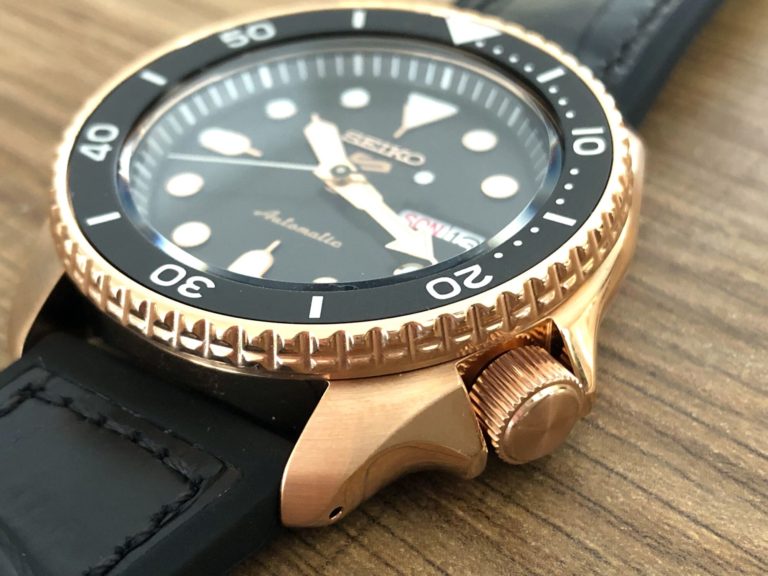Affiliate Disclosure: As an Amazon Associate I earn from qualifying purchases. Details
When it comes to watches, there are a variety of different clasp types. Some are simpler and more basic, while others are more complex. Here we’ll take a look at some of the most common types of watch clasps, what they do, and how they work.

We’ll also discuss their pros and cons so that you can decide which type is right for you.
So let’s get started!
What Is the Clasp on a Watch?
But first off, what is the clasp you find on a watch?
The clasp is either the opening or the widening mechanism that holds the two ends of the watch band together. It’s an important part of the watch, and there are many different types of clasps available on the market.
Types of Watch Clasps
There are eight widespread clasp types:
Let’s take a closer look at each one.
1. Deployant Clasp
The deployant clasp is the most popular type of clasp. It’s a folding clasp that has two arms with locks that fold over each other to hold the band in place.
The deployant clasp is very secure and rarely comes undone, but it can be difficult to open and close when you’ve never done it before.
In order to open a deployant clasp, place your fingertip/nail under the smaller lock and pull it open. Next, unlock the bigger one. To fasten a deployant clasp, do the procedure the other way around.
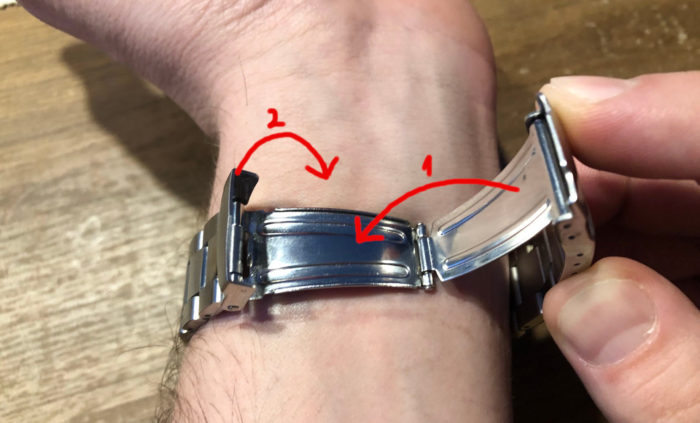
The first-ever deployant clasp was created by Louis Cartier in 1910. The word deployant comes from the French and means “to unfold” or “extend.” The English version of the term is deployment; however, the watch industry uses the French version instead.
The best thing about the deployant clasp is that it is secure. Also, it looks visually more appealing than many other types of clasps. The only downside to it is the somewhat complicated opening.
2. Push-Button Deployant Clasp
The push-button deployant clasp is very similar to the deployant clasp, but it has a small button on either side of the arms that you can press to open the clasp. This type of clasp is much easier to use than the deployant clasp and is perfect for people with limited dexterity.
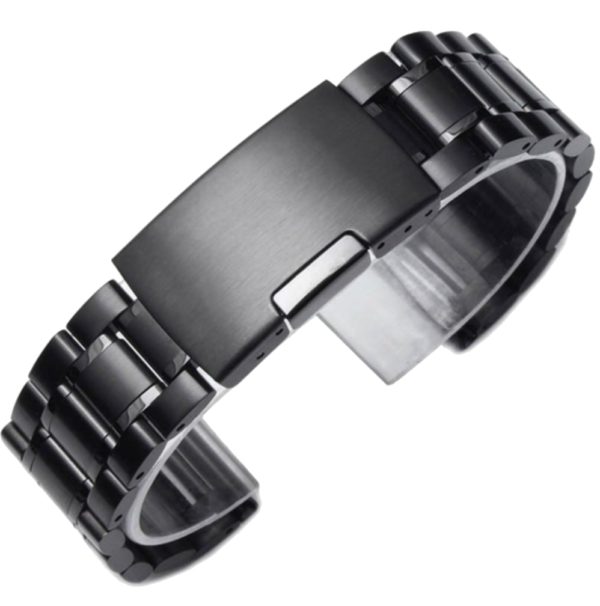
Opening a push-button deployant clasp is easy – just push the buttons simultaneously, and the clasp pops wide open.
To fasten it, bring the clasp arms together and push them together to lock.
Many prefer push-button clasps precisely because of their easy-to-use character. They’re also secure and rarely pop open as you would have to push both of the buttons together, which is quite unlikely to happen accidentally.
3. Fold-Over Push-Button Deployant Clasp
The fold-over push-button clasp is the hybrid of the previous two types of clasps, making it extra secure. Unfortunately, the visual side is sacrificed to the additional security as it is quite bulky aesthetically. Also, the opening and fastening procedures are far more time consuming.
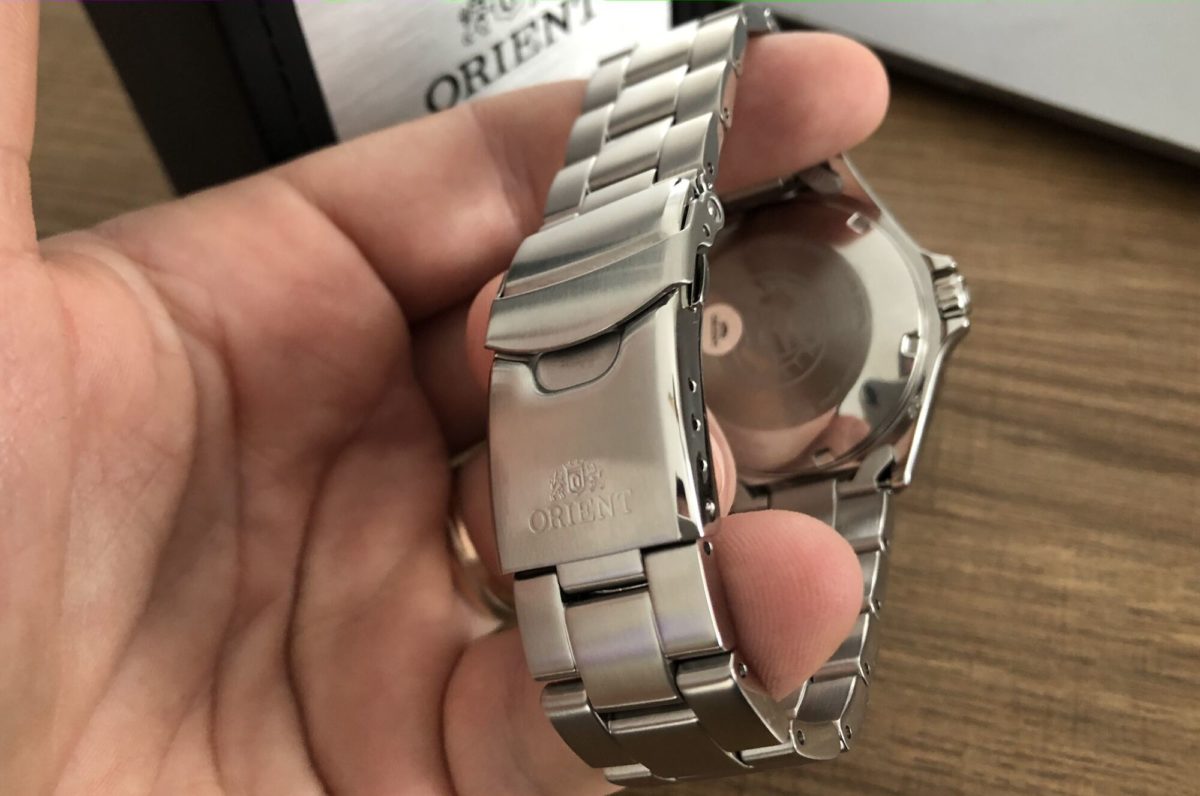
To open the fold-over push-button clasp, you have to first unlock the smaller lock and then push the buttons on either side of the bigger clasp, opening the second lock. To fasten it, lock both of the clasp arms.
Since it takes three locks to open, the fold-over push-button clasp is widely employed in sports watches where security is extra important.
4. Butterfly Clasp
The butterfly clasp is a popular clasp that has two arms that open up like a butterfly’s wings. Similar to the fold-over push-button clasp, this type is very secure and rarely comes undone since it consists of two lockable arms.
There are two types of butterfly clasps – with locks and with buttons.

To open the butterfly clasp with the lock version, just place your finger beneath the clasp and pull until it pops open. The button version of it is as simple as it sounds – it opens by simultaneously pushing the buttons.
The butterfly clasp is visually the least noticeable. It is a good thing because it gives a beautiful continuous look to the bracelet. However, compared to the above three, it is not as secure.
Due to the fact that the butterfly clasp provides a continuous look, it looks the best out of all the types of clasps when wearing your watch inside the wrist, i.e. the clasp outside. So, if you are one of those rare watch wearers who does that, the butterfly clasp is the type to go for.
5. Tang Buckle Clasp
The tang buckle clasp, also known as the pins and loops clasp, is a widely employed clasp that uses metal pins and loops to hold the band together. It has the same working principle as with typical belts, so opening and closing the tang buckle should be easy for everyone.
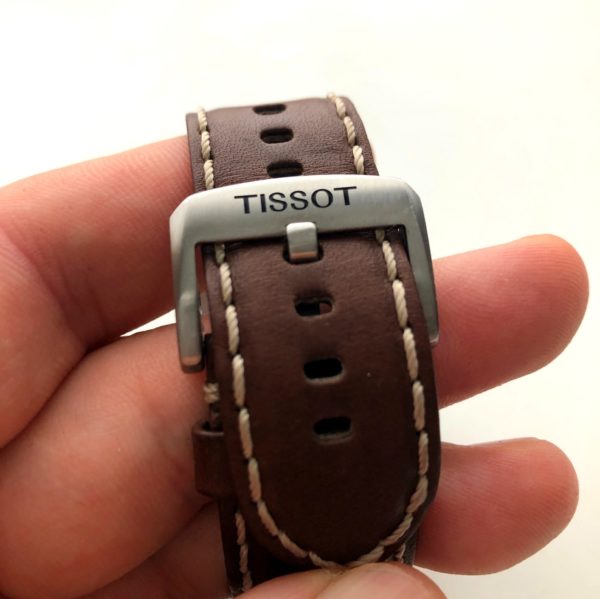
This type of clasp is mainly employed in leather and rubber bands by almost every watch manufacturer out there.
However, the tang buckle is not as secure as several other clasps. The problem is that when the pin holding the tang buckle isn’t good quality, it can fall out of the band. Fortunately, this is the case with lower quality bands and shouldn’t become much of a problem in most cases.
You’ll find this type of clasp mostly in dress watches and casual everyday watches.
6. Velcro Strap
The velcro strap is an unconventional type of clasp that uses velcro to hold the band together. This type of clasp is not as popular as the other types, but it’s still available on some watches, mainly cheap beater watches and kids watches.
Timex is probably the most famous brand that employs velcro on some of its watches.
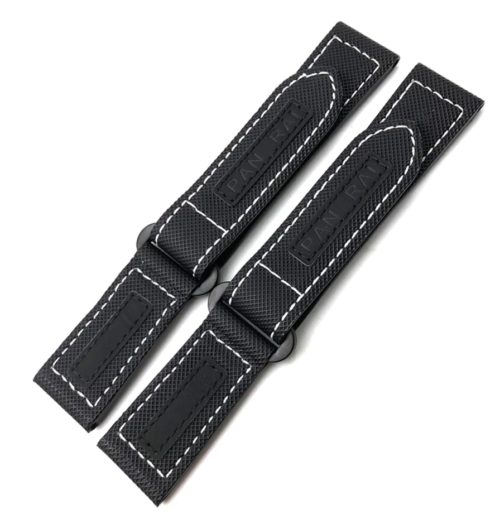
To fasten the velcro strap, take the end with no buckle through the buckle and push it onto the velcro once it has reached your desired tightness around the wrist.
In my sincerest suggestion, go for any other type of fastening than the velcro – it is just too industrial and looks hideous on a watch.
7. Sliding Buckle
The tang buckle has been around for centuries, and it’s still one of the most popular styles. However, there is a new variation that takes this style up a notch – the sliding buckle.
Instead of using pins and predetermined holes to secure your bracelet, you can simply slide the pin on the bracelet until it meets exactly where desired and then clamp down on it.
The best thing about it is its super easy use and the fact you won’t have a gap between the bracelet and your wrist.
This particular buckle is perfect if wrist size often changes because all sizes will fit easily with no extra holes needed. You can find the sliding buckle from mesh straps where the sliding and clamping are the most favorable.
8. Jewelry Clasp
The jewelry clasp is an old-fashioned type of clasp that is the same as in the jewelry. It is a friction-fit clickable clasp that is most prevalent in women’s bracelet watches.

To fasten the jewelry clasp, place the thin bar through the latch and fold it. Finally, press on it until it locks. Unlocking it is even easier – just pull the latch open.
The security of this clasp is the lowest compared to others on this list. However, since they’re mostly used in jewelry-type watches, you won’t be needing much security anyway.
Which One Should You Choose?
Now that you know all about the different types of watch clasps, it’s time to decide which one is right for you!
If you’re looking for a clasp that is easy to use, then the push-button deployant clasp and the tang buckle are the best options.
However, if you’re looking for a clasp that is very secure and you are willing to sacrifice the ease of use, then the deployant clasp and the fold-over push-button clasp are your best options.
And if you don’t have any preferences for security or ease of operation, go for the butterfly clasp or the sliding clasp because they differ significantly from other types and are unique.
Final Take
Watch clasps are an important part of a good watch. However, when you’re looking to buy a watch or a strap/bracelet, it can be difficult to know which clasp is the best for your needs because there are so many options available.
The most common types include deployant clasps and tang buckles, but each has its own strengths and weaknesses. It may seem like a daunting task figuring out which clasp will work best for you, but by understanding the pros and cons of each style, we hope that this article makes choosing a little bit easier!
You may also like:
Affiliate Disclosure: As an Amazon Associate I earn from qualifying purchases. Details
- CIGA Design Blue Planet Gilding Watch: The Best Conversation Starter Around? - April 2, 2023
- CIGA Design X-Series Review: The Most Skeleton for the Money? - July 7, 2022
- What Is A Dive Watch? A Complete Guide - May 17, 2022



